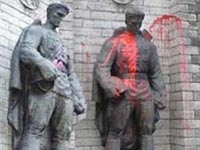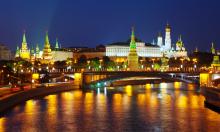Estonia launches another brutal attack against Soviet past
The Estonian authorities are preparing to launch another attack on the Baltic state’s Soviet past. The monument to the Soviet Warrior-Liberator may be removed from the centre of Tallinn. In the eyes of the Estonian authorities and nationalists it is not a sign of respect to the people who gave up their lives to liberate their country from the Nazis, but a symbol of the “occupation”.

Last Saturday a small (although maybe 300 people is a lot for the Estonian capital), but extremely vociferous rally took place in the centre of Tallinn involving supporters of nationalist organizations. People both “for” and “against” took part in the rally. There were those “against” the presence of the monument in the centre of the city, and those “for” it to be placed somewhere a bit further out of sight. So that it does not remind everyone how the small Baltic nation suffered under the yoke of Moscow … Furthermore, some of the more tempestuous Estonian guys suggested not simply removing the monument, but demonstratively blowing it up. Especially fervent people even started to wrap ropes around the statue in order to clearly demonstrate to those present how they should treat “these kinds of monuments”.
On Saturday night several heavily drunk young people poured paint over the statue. The vandalism of the “freedom fighters” did not at all provoke the reaction which the nationalists had been hoping for – in the morning some inhabitants of the Estonian capital brought flowers to the monument…
The Estonian Head of State Andrus Ansip also got involved, and it emerged that he too had long been disturbed by the presence of the statue. The monument to the Warrior-Liberator “is a symbol of the occupation and it should have been removed to another place a long time ago”, just as was done 15-18 years ago with other Soviet monuments, Ansip said on Monday.
According to him, the monument, which originally stood as an epitaph, “has become a symbol of the occupation which cannot be tolerated any longer”. At the same time, the prime minister suggested that this problem should be solved correctly and within the law: “It can be transferred to Siselinn cemetery. If it emerges that soldiers were buried under the monument, then their remains will have to be reburied.” Of course it would not make a good impression for the head of state to climb onto the monument with some rope or pour paint all over it… Although you get the impression that if he had wanted to, Mr Ansip would not have deprived himself of this “pleasure”.
The problem is not just the monument itself. In many Eastern European countries monuments to Soviet soldiers who perished in battles against the Nazis were subjected to the most barbaric treatment at the end of the 80s and beginning of the 90s. This lunacy gradually faded away. But not everywhere – Estonia and its southern Baltic neighbours now serve as a perfect example; for them the former SS are now nice old men, but Soviet Army veterans are occupiers….
As far as the Warrior-Liberator monument in Tallinn is concerned, in recent years it has become a unique symbol of the fight against the authorities’ attempts to rewrite history and rehabilitate their Nazi allies. Each year on the 9th May hundreds of people come to the monument to pay their respects to the soldiers who took part in the Great Fatherland War. For the Estonian authorities this day has long since stopped being a cause for celebration. And for them, just as for the members of a whole array of nationalist organizations, the monument is an immense aggravation. Even if only because in Estonia there are still many people who remember what Nazism was and just how many Soviet soldiers laid down their lives in the fight against it. And who do not agree with people calling them “occupiers”.
Oleg Artyukov for Pravda.RU
Translated by James Platt
Subscribe to Pravda.Ru Telegram channel, Facebook, RSS!




